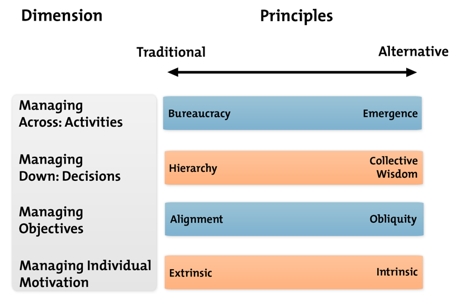(EXTRACTION
FROM TEAM MANAGEMENT: Improving Team Effectiveness at http://www.mindtools.com)
Birkinshaw's Four Dimensions of
Management framework highlights four dimensions that represent key management
processes and practices.

Use the framework to think about the
approach to management that is currently being used, and to explore whether there
is a more effective management model that can developed.
BIRKINSHAW'S FOUR DIMENSIONS OF MANAGEMENT
FRAMEWORK
|
|
1. Managing Across:
Activities
(relates
to how managers coordinate activities with people over whom they have no
direct control)
|
|
Bureaucracy
|
·
organizations
use formalized rules, job roles, procedures, and formal guidance to get
things done
·
Results are
predictable
·
A certain
amount of bureaucracy is needed in most organizations
·
The
downside:
o it can make change difficult to achieve
o it can disengage and demoralize team members
|
Emergence
|
·
is
spontaneous and is based on independence and autonomy
·
People
organize themselves, work independently, and take appropriate action quickly
·
The
downside:
o teams and organizations can feel chaotic and
disorganized
o People can lose focus because there are too few
boundaries and rules in place
|
2. Managing Down: Decisions
(relates to how people make decisions
in the organization)
|
|
Hierarchy
|
·
is based on
authority and power
·
can
motivate people to work hard in the long-term
·
The
downside:
o assumes that "the boss knows best”
o can block upward communication
o can lead to poor decision-making by powerful
people
o can also lower morale and engagement if managers
don't listen to and support to team members, or if they don't give people
credit for their contributions
|
Collective Wisdom
|
·
people
across all levels of the team and organization contribute to decision-making,
and work to solve problems collectively
·
improves morale
and engagement
·
leads to
better decisions when knowledgeable people are involved in the
decision-making process
·
The
downside:
o can take a long time to make decisions if too many
people are involved in the process
|
3. Managing Objectives
(relates to how people set and pursue
organizational goals)
|
|
Alignment
|
·
everyone
works towards common goals
·
The
downside:
o use key performance indicators to measure progress;
can be ineffective or counter-productive in hard-to-define areas such as
creativity and innovation
o too much focus on short-term results
o gives people less flexibility in how they reach
their objectives
|
"Obliquity"
|
·
people
pursue goals and objectives indirectly
·
team
members are also encouraged to work towards their own individual goals
·
team
members have greater ownership over their work
·
they decide
how they reach their goals
·
The
downside:
o people can lose direction and momentum
o they can be wrong in their intuitions
|
4. Managing Individual Motivation
(relates to how people are motivated
in the organization)
|
|
Extrinsic
|
·
approaches
to motivation that come from outside (pay raises, promotions, or praise)
·
easy for
organizations to measure performance and reward team
·
The
downside:
o these drivers don't always address the deeper
needs
o can leave us feeling dissatisfied, disengaged,
unhappy, and unfulfilled
|
Intrinsic
|
·
rewards
that people experience from doing a task or activity well
·
often very
satisfying
·
The
downside:
o difficult to manage
|
Applying Birkinshaw's Four Dimensions of Management
In reality, many organizations will be
on the left-hand end of each scale. The
challenge for managers comes if they want to move from more traditional
management principles to the alternative principles.
HOW TO USE
Birkinshaw's Four Dimensions of Management
|
|
Moving from Bureaucracy
to Emergence
|
A certain level of bureaucracy is
necessary to run an organization effectively but, often, organizations get
bogged down in it.
·
reviewing
organization's business processes and procedures
·
eliminate
unnecessary steps
·
map
processes out, and challenge the necessity of each step
·
remove
bureaucracy and improve processes and procedures
·
work on
building a culture of trust, so that people know that they are trusted to do
their jobs properly without excessive bureaucracy
·
empower
your people
·
avoid micromanagement
·
encourage
use of initiative
|
Moving
from Hierarchy to Collective Wisdom
|
Some level of hierarchy is essential
for most organizations to function.
·
build an
environment of trust, so that you encourage your people to communicate with
one another and speak freely without fear of being judged negatively
·
involve
people in collaborative decision-making
·
encourage
people to use social networking tools such as blogs, intranet forums, and
Twitter to communicate with one another
·
ask people
to present their ideas at team meetings
|
Moving
from Alignment to "Obliquity"
|
·
establish a clear mission
·
give people flexibility in how
they'll work towards this mission
·
give people a dedicated time-slot
during the working week to "follow their hunches”
·
review projects regularly
·
give backing to those that show
potential
|
Moving
from Extrinsic to Intrinsic Motivation
|
It best to motivate your people using a combination of extrinsic
and intrinsic motivators.
Each person is motivated by different things.
·
understand what motivates them as
individuals
·
understand what type of work suits
their personality and their strengths
·
allow them to craft their jobs to
suit them better
|

No comments:
Post a Comment